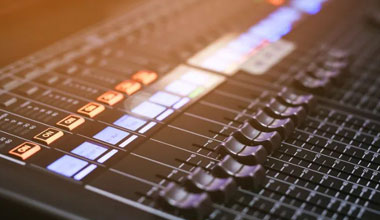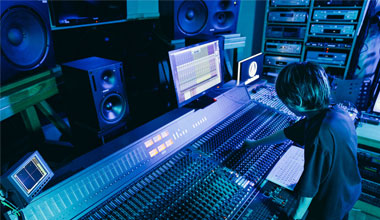
2024-01-02
How to choose the sound system for places like KTV?
In the entertainment audio industry, entertainment consumption venues like KTVs need to select suitable audio equipment for their stores before opening, and how to choose and what factors to consider need to be carefully monitored. Industry competition is an inevitable presence in the market. Throughout the entertainment and audio industry in recent years, the market has gradually become saturated. The transparency of the industry and the influence of the overall environment have also made the competition situation in the industry more intense.
01 Sound effects are the core competitiveness
How to choose audio equipment and which product to choose is related to the experience of KTV consumers. With the development of the entertainment industry, the number of users in the consumer entertainment industry is gradually increasing, and consumers have a higher level of demand for the entertainment experience. Furthermore, for entertainment venues like KTVs, a good sound experience will leave a deep impression on customers, especially those who consume in mass sales KTVs. The proportion of customers who have requirements for singing effects is also increasing. Analyzing consumer psychology, good sound effects not only bring a good experience, but also enhance people's sense of consumption pleasure and satisfaction, and the probability of repeat consumption will be higher.
Just like the front-end effector, as an indispensable part of the sound system, it needs to stand from the perspective of professional sound, maintain a "picky" eye for product sound effects, and strive for excellence in hardware or software. However, sound effects, as a core component of KTV, are often overlooked by KTV owners and managers. KTV operators need to understand that sound effects are an important part of KTV's core competition. They can create huge value for customers, and the products or services they provide can touch the most concerned, core, and fundamental interests of customers. The President of Haier Group once said, "Innovation is the true core competitiveness of enterprises, because it is not easy or impossible to be imitated by competitors." Therefore, when choosing sound equipment, sound effects are always the most important consideration, It can directly affect the consumer's evaluation of this KTV after its opening.
The most crucial aspect of sound performance is the expressive power of the speaker. A high-quality, professional, and well-known speaker product is the foundation for KTV sound effects to gain user recognition and a powerful guarantee for users to continuously consume.
02 Price is the basis
The choice of audio equipment lies with the KTV client, but it is also a double-edged sword. The good thing is that they have a home advantage, but the final delivery quality is controlled by the audio engineering provider. So, how to obtain cost-effective equipment is the second factor that Party A needs to consider. To make the selection more efficient, you can develop an investment plan in advance based on your own situation. Developing an investment plan in advance can not only outline alternative products, but also ensure that the price of the equipment is within one's controllable range, in order to avoid the selected equipment price exceeding one's expectations and not being accepted. Furthermore, without any planned choices, it can lead to inefficient time loss, and for sound engineers or manufacturers, it can also bring unnecessary "sunk costs", which is a waste for both parties.
Price is the foundation. When purchasing audio equipment, balancing the relationship between price and quality, in layman's terms, means getting what you pay for. Losing good products for a low price is not advisable, and choosing the optimal price within a limited range of products is an important foundation for ensuring the quality of delivery.
03 Word of mouth is for reference
Just like when consumers choose which KTV to go to, in addition to considering factors such as sound effects, environment, and price, they also pay attention to the reviews of their friends around them. Just like this, word-of-mouth becomes an important factor that cannot be ignored when consumers ultimately place an order, that is, users learn about other people's comprehensive evaluations of the KTV through various channels.



2024-01-02
The function of a sound mixing console and precautions when selecting it
The sound mixing console, also known as the mixing console, is called Mixer in English. Among them, "Mix" means mixing, and we can usually understand Mixer as a mixer, but the functions of a sound mixer go far beyond these.
A mixing console is a device with multiple inputs, each sound signal can be individually processed and processed for various artistic purposes, and the mixing ratio can be adjusted. It has multiple output sockets (including left and right stereo output, grouping output, mixing output, recording output, monitoring output, and various auxiliary outputs).
The mixing console is widely used in various sound reinforcement systems or recording performances, and is also the most commonly used professional audio equipment for mixers and recorders. It can be said that the mixing console is the most important equipment in professional audio systems, and a professional audio system often takes the mixing console as the core of the entire system.
When choosing a sound mixing console, attention should be paid to five aspects. The mixing console is an important equipment in recording and sound reinforcement systems, and its quality directly affects the sound quality of the sound. Therefore, purchasing a mixing console has strong professionalism. There are many parameters for a mixing console, and generally, frequency response, gain, noise, distortion, and linearity can be used as the selection criteria.
01 frequency response
Also known as frequency response, it characterizes the bandwidth of the mixing station and the consistency of the level within the specified width. Generally, the frequency response requirement for professional mixing stations is 30Hz --18000Hz ± ldB. This is the frequency response of the total channel of the audio mixing station. If the frequency response of the mixing station is not wide enough, both high and low frequencies will be cut off, so it is not possible to record the original sound signal with high fidelity in a wide range. Even with sufficient bandwidth, without a flat frequency response, it is impossible to achieve true recording of the original sound signal. Because the levels of different frequency bands are not consistent, it will inevitably cause signal distortion. So the frequency response of the mixing console should be wide enough and have a flat characteristic. Only in this way can sound engineers or sound engineers have the original basis for signal processing, that is, to increase or decrease by how much in which segment of the frequency band, and to increase or decrease around a certain central frequency.
02 Gain
The gain referred to here refers to the total gain of the mixing station, which is the logarithm (dB) of the ratio of the output voltage of the mixing station to the input voltage. The gain of the audio mixing console is divided into two indicators: maximum gain and rated gain. The maximum gain is the highest level of the mixing station, the rated gain is the rated operating level of the mixing station, and the maximum level is the upper limit of the dynamic range of the mixing station. In the case of microphone input, the minimum gain of the mixing table should not be less than 70B, and the maximum can be above 90dB.
03 Noise
The noise of a sound mixing console is commonly characterized by the signal-to-noise ratio in general electroacoustic equipment to represent the relative relationship between signal and noise. The noise of the mixing console is represented by converting the noise at the output end to the equivalent noise level at the input end. The equivalent noise level converted to the input end is generally required to be around -125dB. In this way, the signal-to-noise ratio of the mixing console can reach 80dB.
04 Distortion
Distortion is a phenomenon in which a simple signal, after passing through a nonlinear component, generates multiple harmonics that alter the waveform of the original signal. This distortion is often referred to as harmonic distortion, expressed as a percentage, and is distinct from linear distortion and intermodulation distortion. The calculation formula is as follows: the harmonic distortion of the mixing table, under the rated output conditions, the total harmonic distortion coefficient THD is ≤ 5%. At maximum output, it should be less than 1%.
05 Linear
The linearity of a mixing console, like other electroacoustic devices, refers to dynamic margin, also known as reserve. The calculation method is the logarithmic value (dB) of the ratio of the maximum output voltage to the rated output voltage. The expression can also be expressed as the difference between the maximum output level and the rated output level. Professional level mixing consoles should generally have a linearity of 15dB to 20dB or higher.



2024-01-02
How to choose and use microphones?
The opportunities for daily use of microphones have increased. Just like you want to hear good sound and record good sound, but when it comes to using microphones, there are various types of microphones that can be overwhelming. People use it differently, whether it's for speaking, singing, or playing musical instruments.
Dynamic microphone, convenient for use at home
When recording vocals or instrument performances in narrow spaces such as at home, considering the surrounding environmental sound and spatial reverberation, which microphone is recommended to use? This depends on the size of the room, but for example, if you are considering a room with 6 tatami mats and the room is soundproof, a condenser microphone is sufficient. However, for a regular 6 tatami room, we recommend using dynamic microphones. Capacitive microphones are very sensitive. There are various environmental sounds, such as the sound of air conditioning. There is also the sound of someone touching the computer. If you don't have to worry about such sounds when recording, a dynamic microphone is the best choice. Additionally, when recording a speech, if you are excited and make sounds like "wow" or "kya", a condenser microphone can distort the sound. It's not that the microphone is distorted, but rather that the mixer or audio interface controlling it is prone to distortion. High sensitivity=it is difficult to increase the input, and even if it is increased, there are still inputs that cannot be fully improved, resulting in distortion.
What should be noted when setting up a dynamic microphone?
It depends on where you want to record, but basically I will choose a location and record there. I will maintain this posture without moving. With dynamic microphones, you can record without worrying about distance from the microphone.
Using capacitive microphones can be a bit challenging, including in recording environments.
If you are starting from scratch, we recommend starting with dynamic microphones and gradually getting used to them. If you want to record a wider range of sounds or include various sounds, we recommend using capacitive microphones. However, condenser microphones are very sensitive and can pick up sound from adjacent rooms, so you must change the environment.
Capacitive microphones are also very expensive.
But there is no reason to believe that more expensive and high-end microphones are better. This depends on the actual situation. During sports broadcasting, the sound of a football being kicked or a baseball bat being struck can be clearly recorded. That is a condenser microphone, which was recorded using a very long directional microphone. That's why some condenser microphones can record a wide range of sound, while others record it in a precise manner. I choose different microphones according to the situation. In short, microphones will not be of great use unless their purpose and content match. That's why choosing becomes difficult.






